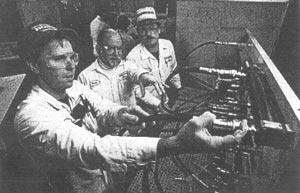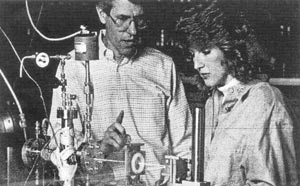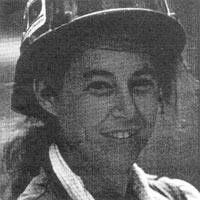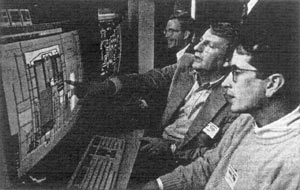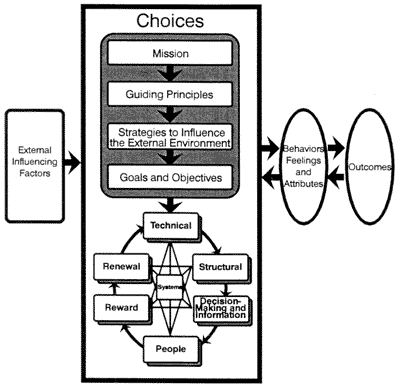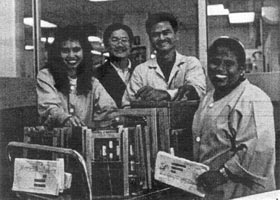
A Company Of Business People
Organization Planning & Design - By Mark Rhodes and Paul GustavsonA New Era
To achieve the dream of being the world's best manufacturer, workers at this facility spend time learning about all the steps in the creation of their product. A new era in business has arrived. Gone is the "do as I say" attitude and tight control of workers by management. The new business model encourages workers to make critical decisions about how the work is done. Companies around the world are counting on teams of empowered people to lead the way to business success. Entrusted by these innovative companies, workers are thinking and acting as true business partners.
In effect, teams of workers are given the opportunity to "run their own business." The key to their success is achieving critical balance-companies must meet the needs of their customers, their employees, and their stakeholders.
Mission and Purpose
The hallmark of this new "company of business people" is the sense of mission and purpose for each and every member of the organization. Workers who feel that their own sense of purpose is congruent with the mission of their company have proven more productive and more fulfilled by their work life.
At the Hill's Pet Nutrition facility in Richmond, Indiana, for example, most workers can tell you that their company mission is to be the "global leader in pet nutrition." As David Cleveland, a Hill's technician says, "it's exciting to be part of a global mission. I feel as though I am helping to shape the future of our industry."
Guiding Principles
Workers at these innovative companies adopt a set of principles that guide their behaviors. Since the company cannot foresee all circumstances that a worker may face, it must trust that workers will make appropriate decisions based on a common set of guiding principles.
AT&T Capital Corp., for example, begins communicating their "Bringing the Best Together" philosophy with new workers during their first day with the organization. New workers are expected to learn such guiding principles as "mistakes are to be treated as learning experiences," and "consider the impact on your teammates before acting." These guiding principles are then reinforced continuously in company communications and newsletters, through team meetings, and through occasional informal meetings with company leaders.
Citing a value of "contribution" and "value for value," team members at Hill's award winning Richmond plant agree to make up for time missed due to illness by providing time or effort of equal value. And you won't see Hill's workers dashing off before the end of their shift. Because of a guiding principle called the "feel good factor," team members do not leave their work in the hands of the next shift until the next person on duty feels good about the handoff. To comply with this principle, workers must ensure that all relevant information has been passed on to their team mates on the next shift.
Another important principle enhancing work at many of these companies of business people is the value of participative decision making. I/N Tek has proven one of the most successful companies in its industry in recent years.
Understanding Company Strategy
Workers at this facility visit with customers to learn what "quality" means to those who will use their products. In a traditional company, those at the "top" create strategy and those at the "bottom" are simply expected to do as they are told. More and more, though, innovative companies have found that educating the work-force on company strategy can improve company performance.
At Varity Kelsey-Hayes, a maker of anti-lock brake systems, periodic visits by such customers as General Motors are scheduled in order to educate workers on specific customer requirements. "We find that there is no substitute for letting our people get answers to their questions directly from their customers," says Karen Jackson, the Human Resources Manager at Kelsey Hayes' start-up facility in Fowlerville, Michigan. Connecting workers with customers enables them to think like "owners."
In a similar fashion, members of the Hill's Richmond facility spend a day per year traveling with customer service people to various pet stores and veterinary offices. Meeting with real customers adds to the workers' understanding of their business, and customers enjoy speaking directly with those who manufacture the product.
As another example, before recent changes, workers at National Semiconductor's fabrication plant in Greenock, Scotland were asked to make microchips without knowing one type of chip for the next. Now, chips are marked as to their end-use. "I like knowing when I am working on a part for a stereo or a car," says process worker Maria Jenkins. "Feeling a sense of connection to the end-user of our product helps me focus on quality."
Setting Goals and Objectives
As in any organization, these new companies of business people must set top-down goals based on corporate wide business needs. To instill a sense of business purpose, however, many innovative companies are involving team members in the goal setting process. "Our hope," says Cerie Scwenck, Operations Manager at Fres-co System USA "is that every worker believes that our plant's goals are achievable… a stretch perhaps, but something we can accomplish together if we work as a team."
A well organized set of goals and objectives can serve to focus employees' attention on the performance metrics that matter most to their customers. Some time ago, for example, National Semiconductor learned through a series of customer interviews that their goals were internally focused, and that high performance on these internal metrics meant little in the competitive marketplace. A change in the measures used for goal setting led to improved competitive performance.
Technology and Innovation
A Company of Business People provides workers with the opportunity to run their own business. There is no doubt of the impact of automation and information technology on modern business. American Transtech took advantage of both of these in the design of their customer-focused, team-based organization. As they developed their capabilities and became more proficient, they were able to grow four new businesses staffed with team members from their original core business. Jobs were eliminated from the original organization, but there was no net loss of employment opportunity.
Globally, many companies are employing fewer workers to accomplish more. Though some may feel frightened by this sign of the times, workers who think like business people can use automation to their advantage. "We are removing much of the repetitive and routine work that used to be so boring," says Jim Wilsbacher of Bristol Myers Squibb, "we count on our team members to be thinkers and problem solvers, not laborers in the traditional sense.
New approaches to technology and innovation are helpful in the government sector as well. Stew Liff, Regional Director of the award-winning Veterans Benefit Administration credits creating a Visual Office utilizing information technology as powerful aid assisting his team to have the right customer, financial, and production process information available to meet their customer, stakeholder and member requirements.
The Power of Cross Functional Teams
General Electric's success with recent start-up facility in Europe, Mexico and the United States illustrates the power of "multi-functional" teams, in which members share end-to-end responsibility for producing an identifiable quality product. Every worker is a member of a team consisting of ten or so members. Each team meets weekly to discuss problems and challenges occurring as their products roll from upstream to downstream in the manufacturing process. Meeting as a team enables workers to learn about the impact of their own efforts on those working downstream. To supplement this learning, workers learn "six sigma" quality tools and are cross trained and rotate periodically to take other roles in the work flow.
In a similar fashion, Zilog reorganized its high performance semiconductor around its conversion processes twenty years ago. Zilog's Nampa, Idaho facility, for example, organized operators, maintenance personnel and engineers into "state change teams," so that a team of technicians oversees the production of a computer chip through a conversion process from end-to-end, from input to identifiable output. "Before our redesign efforts," says star-up Manufacturing Manager Mark Auble, "the product would pass back and forth from one functional team to another. Each hand-off allowed the possibility for what we call variances [defects in the product]. The new cross functional team design minimizes the number of hand-offs, and the possibility of error."
A Team Development Model
The Team Development Model. This graphic shows how the role of the Team Coordinator, depicted as the darker circle, changes as the team develops. Stage One is very similar to a traditional supervisory role, since the team is largely undeveloped. By Stage Five, the team is truly self managing. In recent years, many companies have made the mistake of trying to move teams immediately from Stage One to Stage Four or Five. Often, teams require twelve to eighteen months in each stage before they are ready for a new style of leadership from their Team Coordinator. Sadly, many companies have struggled with the topic of worker empowerment. "We find that a lot of companies try to give teams too much responsibility too fast," says Rick Spann, Director of Manufacturing at Colgate's high performance manufacturing facility in Cambridge, Ohio. "Putting too much decision making load on a team too fast can damage workers' confidence when they struggle. We encourage our teams to think of team development as a gradual process. Eventually, teams can take on a variety of responsibilities traditionally performed by management. These team responsibilities can include setting team goals, providing performance feedback for teammates, selecting new team members, and dealing with performance problems-even de-selecting those who do not improve." A powerful Team Development model intended to help organizations with these challenges is shown below.
"Each of our teams keeps track of their progress toward greater self management" says Marc Swartz, start-up plant manager at Hill's award-winning facility in Richmond, Indiana. "We learned that the team development process takes years, not months. But we are on track toward truly empowered teams."
As an example of what a team can do, work teams at BHP's Building Products facility in Somerton, Australia have begun to assign their own work schedules, and are now responsible for measuring yields and selecting new team members-tasks traditionally controlled by supervisors.
The Role of the Team Coordinator
Lynn Cavanaugh, Production Manager at Bristol-Myers Squibb's new pharmaceutical facility in Mt. Vernon, Indiana, illustrates how the role of the old first line manager has evolved at these innovative companies. Her role is to develop the team, not necessarily to make decisions. At the same time, she must ensure that a team development model is followed, so that the right people make the right decisions.
In some companies, managers fear participative management as a loss of power, and may even feel angry about losing status that may have taken years to achieve. Nonetheless, says Tom Ward, Supply Chain Vice President at Mead Johnson Nutritionals, "the team coordinator role is key to successful creation of a company of business people. These days no one has more job security than a leader with skill at developing teams. A leader with these kinds of people skills is valuable in the kind of company we seek to design."
A Wealth Creation Model
In Somerton, Australia, workers in BHP's Building Products facility can log in to a computer to check the up-to-the-hour financial performance of their team's "Wealth Creation Model." "It makes me feel good to know at the end of the day that we made money for the company," says a team member "when we are making money for the company, we feel more secure and more like winners. When we lose money on the day, we get together to learn form our experience."
This sort of information sharing could never happen in a traditional, hierarchical company. In the old way of doing business, financial information was the exclusive tool of senior management. Withholding financial information, more often than not, hindered the ability of companies to adapt quickly to changes in their business environment.
To ensure that technicians will think "like business people," BHP puts them through the same business simulation exercises provided for leaders of the organization. Everyone is trained to understand every detail of the company's financial performance. By tracking weekly "wealth creation" and cash-flow reports, workers learn how the company makes a profit, and how they can contribute to company success.
Developing Competencies
By employing a Wealth Creation Model, workers know how well their team does each day because performance measures are shared. Information should be used to promote learning, not to assign blame. More and more, companies compete on the basis of the collective knowledge of their work force. Steve Crossingham of BHP says, "these days just having financial resources is not enough. The purest source of competitive advantage is knowledge-knowledge about your customers, about your product and work processes, and about how people can work more effectively together. Your workers must be more knowledgeable that the competition so you can adapt faster to changes." To compete in the ever changing world of business, companies must excel at selecting, training and developing employees.
Australian steel maker BHP, for example, puts all candidates for selection through a carefully designed "assessment center" at its new facility in Somerton, Australia. People applying for a job go through a series of exercises and interviews designed to help them understand what the work will be like, so they can decide for themselves whether to pursue working for BHP. The selection process is also designed to determine whether the individual's work ethic, capabilities, and principles are in line with those of the company.
Once selected, new team members will participate in a learning process designed with the same care that went into the selection process. Not the word learning - this is more than just a training program. Knowledge is developed through a variety of methods, from hands-on coaching to computer presentation to work-place simulation.
Rewarding Contributions
Since members of these new companies of business people will be asked to think like owners, they will naturally want to receive some reward for their contribution. Recent research has shown that people require more than just financial compensation for their efforts. In fact, financial reward is generally found about midway down the list of human motivators. Topping the lists in university studies are such individual needs as the opportunity to learn and grow, to be appreciated for unique contribution, and to have meaningful, interesting work. More and more, innovative companies are finding new ways to show appreciation for workers and to build some enjoyment into the work.
Monetary compensation, of course, can also focus attention of the kinds of behaviors, feelings and attributes that company wishes to promote. "We see a lot of companies where compensation drives the wrong behaviors," says Tim Ohara of GE, who has been involved with several high performance facilities. "We have found that people do what they are measured and rewarded for doing. If rewards and measures are not aligned properly to drive the behaviors that you desire, such as teamwork and sharing knowledge, then don't be surprised if you get individually-oriented behaviors.
Many innovative companies are turning to "performance sharing" as an alternative to simply rewarding people for putting in hours. At AT&T capital, for example, every employee can receive up to 25 percent of their gross pay each quarter as a bonus, based on company performance. The individual's share of the payout is determined by his or her own contribution, as rated by teammates.
Developing a Learning Organization
Companies of business people are aware of the importance of continuous learning. At American Express Financial Advisors, advisors meet regularly in action learning sessions. In these sessions, they discuss learnings by sharing successes and failures. "Our veteran advisors meet often to find ways we can do our work smarter," says Diane Ruebling, the Field Vice President for South Texas. Often, process improvement teams are formed to tackle especially challenging problems.
While daily shift change meetings and weekly team meetings keep team members abreast of important information on a daily basis, a more comprehensive look at the changes going on in the environment I essential for steering an organization in these companies design an annual renewal process into their way of doing business. AT&T Capital Corp., for example, involves workers from all levels and divisions of the company in an annual planning cycle. Each year, members of a renewal team examine the environment and learn about changes among customer segments, regulators, stakeholders and competitors. Outputs of this process are employed in determining company strategy.
The Organizational Systems Design Model An agreed upon framework for renewal is an essential tool. The Organizational System Design (OSD) model, shown above, is a proven framework for understanding and designing high performance companies of business people.
For example, members of the Hill's Richmond facility conduct an annual renewal process which involves all workers in the continuous redesign of their facility. "We use the Organizational Systems Design Model as a framework for looking at our organization," says Plant director Kelvin Graham, "we find that having a model and methodology for renewal keeps us focused on the important things, like our customers, our business, and each other."
Organizing for the Future
Like any living system that must adapt to changes in its environment, organizations of today must adapt to the increasingly competitive marketplace in this age of globalization and automation. To compete in the next millennium, companies must shed their bureaucratic decision making structures built for the more static business environment of the past. To excel in the days ahead, innovative organizations must truly become companies of business people.
You get what you design for, as illustrated by these great organizations. Creating a "company of business people" does not happen by chance. Rather, it is the result of a set of conscious choices. We believe very strongly that "organizations are perfectly designed to get the results that they get." Therefore in order to create a company of business people, it is essential to have a vision of just what such a company is, as well as a framework and a set of tools to serve as a blueprint and guide for designing such a company. Finally, you must maintain a passion for creating a company of business people.
In a world where competitive advantage is essential for success, we believe creating a culture of "business people" is one of the most powerful strategic choices a company can make-whereas products and services can be easily imitated, it is difficult to copy or imitate this culture of a company of business people.

